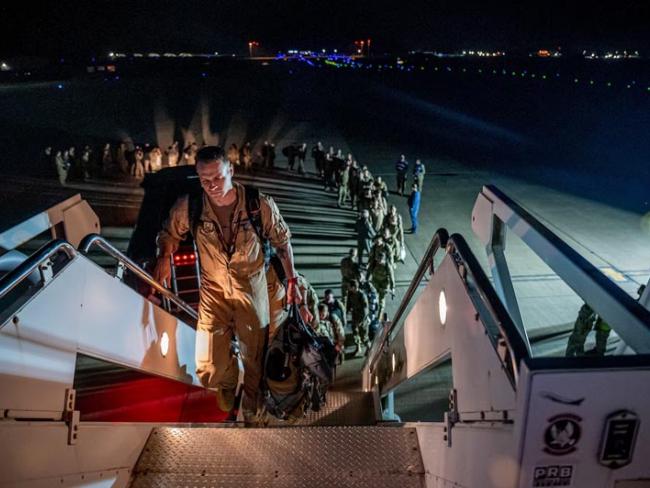
10 October 2023: US airmen leaving RAF Lakenheath for an “undisclosed location” in southeast Asia. Photo USAF/Airman First Class Seleena Muhummad-Ali.
Once again, the US is seeking to make even greater use of its bases in Britain. And once again, opposition is building…
The question of sovereignty in Britain has been put into sharp focus by the likelihood that US nuclear weapons and bombers will once again be stationed on British soil. An article in Workers in September 2023 pointed to the persistent and concerted campaigning that led to the removal of this weaponry from the US air base at Lakenheath in Suffolk in 2008.
But the operational facilities were mothballed – not removed. And indeed Britain is once again on the list of countries prepared to host US nuclear weapons. The US Defense Department compiles such a list annually in its Military Construction Program. It indicates that RAF Lakenheath has now acquired nuclear status, with nuclear-capable F-35A Lightning II fighter bombers being deployed to the base, the first in Europe to get such aircraft.
In the 1980s, at the height of the Cold War, our predecessor paper The Worker used a cartoon of Britain as an aircraft carrier doing the USA’s bidding. We are in danger again of losing control, with a foreign power deciding our fate on questions of war and peace.
Many people in Britain now recognise the perilous nature of this situation. Opposition to such domination is building once more. The role of NATO in ignoring democracy and sovereignty is becoming clearer.
Sophie Bolt, vice-chair of CND (which organised protests at Lakenheath base last year), pointed out the danger: “The upgrade of US nuclear infrastructure is nearing completion, with bases across Europe set to receive the B61-12, if they have not done so already. NATO nuclear doctrine endorses a first-use policy, so these bombs – which use guided targeting for greater accuracy – are not intended for defensive purposes. Their method of delivery, the F-35, is a stealth fighter with a range of 2,200 km. This suggests that they will be used to target Russia – and therefore put us on the front line in any future US/NATO war with Russia.”
Growth of US bases
The story of US infringement of Britain’s sovereignty goes back decades. US forces remained after the joint efforts in the struggle against Nazi Germany in the Second World War. There has been a continuous presence of US military forces ever since.
British control over them seems to have been negligible. The 1951 Status of Forces Agreement provided a legal framework between Britain and NATO for the use of such bases, and the Visiting Forces Act of 1952 incorporated this into British law. These agreements allow foreign military forces to operate within Britain.
‘The law allowing these bases reserves jurisdiction over US personnel to the US government, with public insight severely curtailed…’
By the 1990s there were about 100 US bases here; 13 now remain – all nominally RAF bases. They are at: Lakenheath and Mildenhall in Suffolk; Alconbury, Molesworth and Upwood in Cambridgeshire; Croughton and Welford in Northamptonshire; Fairford in Gloucestershire; Feltwell in Norfolk; Barford St John in Oxfordshire; Fylingdales and Menwith Hill in North Yorkshire; and Blenheim Crescent in Ruislip, London. Not all host aircraft or missiles – Menwith Hill for example gathers signals intelligence.
The law allowing these bases reserves jurisdiction over US personnel to the US government, with public insight into their activities severely curtailed. Currently Britain is host to one of the largest groups of US armed forces posted overseas. There are around 10,000 military personnel, civilian staff and family members based here – and the number is growing.
Notoriously, the other major nuclear weapons system, the fleet of four nuclear capable Trident submarines, is also a hostage to fortune for its lack of full control. The supply of components from the USA – and questions over who determines targeting and use – undermine the idea that this system is an “independent nuclear deterrent”. It is based in Clyde Naval Base at Faslane in the Clyde estuary, with extensive underground storage facilities and bunkers in the hills around Coulport.
Submarine bases
An earlier incarnation of a US nuclear armed submarine fleet saw the building of a US Navy base in the Holy Loch near Dunoon, again in the Clyde estuary, in the late 1950s. This became home to the Polaris submarine fleet and missile system which became operational in 1961.
After the cancellation of Britain’s Blue Streak and the US-led Skybolt missile programmes in the 1960s, the USA began supplying Britain with Polaris missiles and other materiel including launch tubes and fire-control systems, while Britain would make its own warheads. This developed under the terms of the 1962 Nassau Agreement, facilitated by meetings between US President Kennedy and British Prime Minister Harold Macmillan.
Trade unions were prominent in the mass demonstrations that grew in opposition to the base. By 1962 several thousand people were frequently blockading it, many transported there by ships sailing from Glasgow. A spin-off was a folk music revival, with song books printed popularising anti-Polaris songs and poetry.
The Holy Loch base closed in 1992 with the introduction of the longer range Trident missile rendering US ballistic missile bases in Britain unnecessary. The Trident submarine fleet is the system in use today, based in Faslane and Coulport.
The USA is the only country in the world to station its nuclear weapons systems outside its own borders. Britain bears the largest burden of this policy.
Not only does the US nuclear presence render neutrality and non-alignment inoperable, it also undermines our sovereignty. And, by increasing NATO’s capability to wage nuclear war in Europe, it is destabilising and fatally dangerous.
